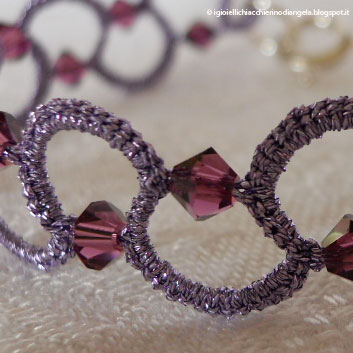A very old art... For very modern jewels!
Date Added: 06/05/2014 Hi there!
Hi there!We wrote it just a few days ago and are going to definitely confirm it here: there's no crafting technique that has proved as brilliantly able to stand the test of time as tatting, literally booming as one of the most fashionable trends in this period!
Seems like everyone is looking for tatting needles - that are easier than tatting shuttles to use - to craft earrings, bangles and any kind of costume jewelry, with truly amazing colors and shapes and, most of all, with no limit to the opportunity of inventing and customizing one's own projects

And, as it often happens in these cases, the Net is acting as a huge mouthpiece, with a number of information and tutorials increasing day by day, highlighting how easy tatting can be, with just some practice, and certainly "at anybody's reach".
In any case, even though more and more used for crafting very trendy and up-to-date jewels, the art of tatting boasts a very old and quite fascinating history.
Though tatting is generally said to be a "Victorian" kind of lace, i.e. dating back to the 19th century, just because it was amazingly famous and fashionable under the reign of the well-known English queen, there are patterns witnessing its existence and quite wide diffusion already by the middle of the 18th century, in France, where it was crafted mainly to embellish the clothes and linens of rich people.
However, even more surprisingly, archaeologists have discovered some pieces of lace and fringes clearly similar to those tatted, in some Ancient Egyptian tombs!
And Queen Victoria wasn't the only one fond of tatting lace, as we know for sure that even the Austrian empress Maria Theresa was given 5 tatting shuttles as a wedding present and even Queen Elisabeth of Romania loved it and she was truly "prophetic" about it, for she wrote exactly as follows: "such a quick and lovely craft will not get lost through the centuries"

Tatting shuttles were very similar to those still marketed now, such as this one here from Prym, for example, and they never lacked in the social gatherings of all, noble, European ladies. And, very probably, the English name "tatting", often used to refer to something like "chatting intensely and in a low voice" and the French translation "frivolitè", certainly reminding us of something "frivolous", though lovely at the same time, have originated just from those gatherings, where ladies used to chat and craft something together: something that's typical of the past and connected to women who could definitely afford it! Both in terms of money and in terms of spare time, of course

At present, we're all not as lucky as these women used to be, talking about free time
 But - at least - this art has truly become at anybody's reach from a financial point of view, thanks also to the success of tatting needles and their user-friendly characteristics!
But - at least - this art has truly become at anybody's reach from a financial point of view, thanks also to the success of tatting needles and their user-friendly characteristics!Tatting one's own jewels, matching color shades, picots, little eyelets and all the common shapes in this art will be a sort of cakewalk and - for sure - it's going to give us, too, people of the 21st century, some hours of "frivolitè" i.e. amusement and mirth

Hear from us soon!

© Cenina S.r.l.
VAT : IT01651310516 - R.E.A. 128424
Fax: +39-0575-033115 - Tel: +39-0575-421407
E-Mail: [email protected]
VAT : IT01651310516 - R.E.A. 128424
Fax: +39-0575-033115 - Tel: +39-0575-421407
E-Mail: [email protected]

 English
English Français
Français Español
Español Italiano
Italiano